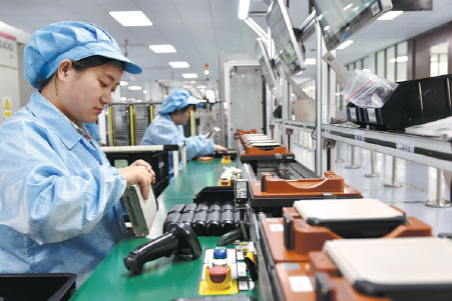Guangxi's 'fruit platter' reaps technological boon


NANNING — Amidst the undulating hills of Qinzhou in South China's Guangxi Zhuang autonomous region, lychee farmer Huang Xinghen is busy picking, screening and packing the pinkish-red, walnut-sized fruits.
"Our freshly-picked lychees normally need three hours to get fully prepped before they are ready for their road trips to destinations like Beijing and Shanghai," said Huang, who has kept his nose to the grindstone since the beginning of the harvest season to deliver orders received from all over the country.
Boasting a long history of growing lychees, Qinzhou has over 1 million mu (about 70,000 hectares) of this tropical fruit. This year has been a bumper year for local lychees as production is expected to exceed 500,000 metric tons, according to the local government.
Lychees, being highly perishable, were mainly consumed locally. According to a popular Chinese saying, it takes only three days for fresh lychees to lose their original color, fragrance and taste.
It is the expansion of cold chain logistics and technological breakthroughs in recent years that have made Guangxi lychees a national favorite and contributed to their popularity in far-flung cities like Beijing.
"Thanks to precooling technologies and comprehensive cold chain transportation, lychees can stay fresh for another three days," said Sun Qinglei, director of the region's agriculture and rural affairs department. "The ability to bring this perishable fruit to people across the country has boosted sales and increased the incomes of local farmers."
Blessed with abundant rainfall and long hours of sunlight all year round, Guangxi has developed the country's largest fruit industry. In 2022, the region's fruit output grew 10 percent year-on-year to surpass 30 million tons, accounting for over one-eighth of the national total, according to the department.
Behind the recent bumper harvest is the local success in promoting agricultural technologies, such as the use of LED (light-emitting diode) light to disinfect lychee trees and the development of high-yield varieties, said Liang Jihao, deputy head of the department.
Over the years, Guangxi has set up seven "fruit innovation" teams of specialists from agricultural institutes to usher in technological innovations. It has also assigned fruit specialists for all district- and county-level governments to promote the use of new technologies, Liang said.
Breakthroughs in farming technologies have also diversified the fruit supplies of Guangxi, expanding the categories of fruit plantations in the region to 300.
Among them are grapes, which were not traditionally suitable for the tropical climate of Guangxi. The change came after the Guangxi Academy of Agricultural Sciences developed heat-resistant and seedless grape varieties and the cultivation turned the region into a new production area for grapes.
Bordering Vietnam, the region has also enhanced its fruit supply capacities in recent years amid booming trade with the Association of Southeast Asian Nations (ASEAN) countries, especially after the Regional Comprehensive Economic Partnership (RCEP) agreement secured access to the Chinese market for more Southeast Asian fruits.
In mid-July, when some of the most popular Southeast Asian fruits like durian, mangosteen and longan are in season, it is common to see a long stream of trucks, loaded with imported fruits, waiting for Customs clearance at the Youyiguan border gate along the China-Vietnam border.
"Our durian business is exploding. The value of cargo we have handled has surpassed 600 million yuan ($83.7 million)," said Li Wenzhi, who runs a fruit import company based in Guangxi.
In the first five months of this year, Guangxi imported 3.66 billion yuan worth of fruit from ASEAN countries, a marked rise of 194 percent year-on-year. Among the most notable increases is durian, which surged 516 percent from the same period last year, according to Customs data.
Xinhua




































